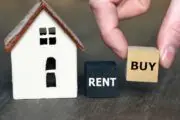If you’re looking to buy your first house but can’t seem to find any affordable options, you’re not alone.
Starter homes – single-family homes with 1,400 square feet or less – used to be a popular option for first-time homeowners in previous decades. In the 1940’s, starter homes were listed for around $6,990 and made up nearly 70 percent of all new builds. By the 80’s, that number dropped to about 40 percent.
These days, starter homes seem to have disappeared from the market entirely.

Image via Pexels
Increased cost of land, zoning restrictions and inflation have driven the traditional starter home to near extinction. Today’s starter homes aren’t the intentionally affordable family homes of the past – they’re simply the cheapest homes on the market, which complicates matters for renters and young families who now need to compete against downsizers and property investors.
For many aspiring homeowners, entering the market feels impossible. Attainable homes are scarce and trying to buy one means facing off against experienced buyers with more money behind them. On top of that, rapidly rising interest rates mean many first-time buyers can’t get approved for a mortgage that costs the same amount as their rent.
It’s dreary picture for many American renters – but how bad is it, really?
To get a better idea of how the situation looks across the country, Point2 reviewed data on the median price of a starter home and renter household’s median incomes in the 50 largest US cities.

Image via Pexels
California renters can only dream of homeownership
If you’re going to San Francisco, be sure to wear some flowers in your hair… but maybe don’t have your heart set on buying a house any time soon.
Average renter households in the city make $100,715 per year, which may seem like a livable income in many other areas – that is, until you realize first-time buyers in San Francisco would need to make $251,190 per year in order to comfortably afford a mortgage payment.
That’s a 60 percent gap between the median renter income and the income required to afford the cheapest homes in the San Francisco market.
While San Francisco is at the top of the list for unaffordability, California seems to have the greatest concentration of unaffordable cities overall.
Renters in Los Angeles and San Jose are also more than $100,000 short of making their dreams of homeownership come true. Long Beach, San Diego, Fresno and Sacramento offer a slightly better picture, but renters in those cities would still need to increase their income by over 50 percent in order to afford a home.
If you’re more of an East Coast person, don’t get your hopes up for New York, either. While it’s not as bad as San Francisco, renters in the Big Apple make less than half the income required to purchase the average New York starter home.
Affordability windows are closing quickly
A lot can change in a month, especially when it comes to real estate.
Affordable cities are becoming unaffordable seemingly overnight, leaving renters who straddle the affordability line in a constant state of limbo. Should they renew their lease for another year, or make the switch to homeownership? The pace at which affordability windows are closing leaves many without a clear answer.
So, what exactly can happen in a month?
Interest rates can make or break your ability to buy a house. So far, they seem to be the cause of growing unaffordability.
In August, when interest rates hovered around 5.5 percent, renters in six large U.S. cities could afford to buy a starter home:
- Detroit, MI
- Tulsa, OK
- Memphis, TN
- Oklahoma City, OK
- Kansas City, MO
- Baltimore, MD
By the start of October, interest rates had hiked up to 7 percent. Kansas City and Baltimore subsequently fell off the list and joined 44 other large cities where renters earned less than what they would need to afford their mortgage payments.
While the dream of homeownership has died for many renters who make less than 50 percent of the income they need to afford a home, a huge chunk of American renters continue to get sucked into decisional limbo as they straddle the affordability line.
Out of the 50 cities considered in the study, renters in 15 of them made between 98 – 70% of the income they need to comfortably afford a home.

Image via Pexels
What do we mean by “comfortably afford”?
The accepted rule for many banks and lenders is that a mortgage payment should not exceed 30% of your gross monthly income.
For the purpose of this study, Point2 looked at the median price of a starter home in 50 large American cities, subtracted a 20 percent down payment and calculated the monthly mortgage payments. Then, they compared the cost of those payments to the average renter’s monthly income.
If mortgage payments made up less than 30 percent of renter’s median income, that means the average renter could comfortably afford their mortgage payments.
So where can renters afford to buy a starter home?
Right now, there are only four large cities where renters can comfortably afford a starter home.
Renters in Tulsa, OK; Detroit, MI; Memphis, TN; and Oklahoma City earn more than what they would need to buy a starter home in the area.
Detroit, Tulsa and Memphis are the most affordable from the list. Median starter homes in all three cities cost less than $100,000, and the average renter earns between $3,000-$5,000 more than the income needed to cover expenses.
Oklahoma City is still considered affordable, but the budget is a little tighter. Renters only make $140 above the required amount.






